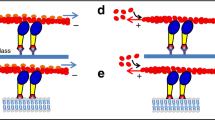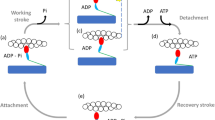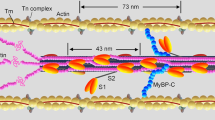Abstract
Many types of cellular motility, including muscle contraction, are driven by the cyclical interaction of the motor protein myosin with actin filaments, coupled to the breakdown of ATP. It is thought that myosin binds to actin and then produces force and movement as it ‘tilts’ or ‘rocks’ into one or more subsequent, stable conformations1,2. Here we use an optical-tweezers transducer to measure the mechanical transitions made by a single myosin head while it is attached to actin. We find that two members of the myosin-I family, rat liver myosin-I of relative molecular mass 130,000 (Mr 130K) and chick intestinal brush-border myosin-I, produce movement in two distinct steps. The initial movement (of roughly 6 nanometres) is produced within 10 milliseconds of actomyosin binding, and the second step (of roughly 5.5nanometres) occurs after a variable time delay. The duration of the period following the second step is also variable and depends on the concentration of ATP. At the highest time resolution possible (about 1 millisecond), we cannot detect this second step when studying the single-headed subfragment-1 of fast skeletal muscle myosin II. The slower kinetics of myosin-I have allowed us to observe the separate mechanical states that contribute to its working stroke.
This is a preview of subscription content, access via your institution
Access options
Subscribe to this journal
Receive 51 print issues and online access
$199.00 per year
only $3.90 per issue
Buy this article
- Purchase on Springer Link
- Instant access to full article PDF
Prices may be subject to local taxes which are calculated during checkout



Similar content being viewed by others
References
Huxley, H. E. The mechanism of muscular contraction. Science 164, 1356–1366 (1969).
Huxley, A. F. & Simmons, R. M. Proposed mechanism of force generation in striated muscle. Nature 233, 533–538 (1971).
Jontes, J. D., Wilson-Kubalek, E. M. & Milligan, R. A. A32° tail swing in brush border myosin-I on ADP release. Nature 378, 751–753 (1995).
Whittaker, M. et al. A 35 Å movement of smooth muscle myosin on ADP release. Nature 378, 748–751 (1995).
Irving, M. et al. Tilting of the light-chain region of myosin during step length changes and active force generation in skeletal muscle. Nature 375, 688–691 (1995).
Molloy, J. E., Burns, J. E., Kendrick-Jones, J., Tregear, R. T. & White, D. C. S. Movement and force produced by a single myosin head. Nature 378, 209–212 (1995).
Coluccio, L. M. & Conaty, C. Myosin-I in mammalian liver. Cell Motil. Cytoskel. 24, 189–199 (1993).
Coluccio, L. M. Differential calmodulin binding to three myosin-I isoforms from liver. J. Cell. Sci 107, 2279–2284 (1994).
Veigel, C., Bartoo, M. L., White, D. C. S., Sparrow, J. C. & Molloy, J. E. The stiffness of rabbit skeletal, acto-myosin cross-bridges determined with an optical tweezers transducer. Biophys. J. 75, 1424–1438 (1998).
White, H. D. & Taylor, E. W. Energetics and mechanism of actomyosin adenosine triphosphatase. Biochemistry 15, 5818–5826 (1976).
Molloy, J. E., Kyrtatas, V., Sparrow, J. C. & White, D. C. S. Kinetics of flight muscles from insects with different wingbeat frequencies. Nature 328, 449–451 (1987).
Suzuki, Y., Yasunaga, T., Ohkura, R., Wakabayashi, T. & Sutoh, K. Swing of the lever arm of a myosin motor at the isomerization and phosphate release steps. Nature 396, 380–383 (1998).
Jontes, J. D., Milligan, R. A., Pollard, T. D. & Ostap, M. Kinetic characterization of brush border myosin-I ATPase. Proc. Natl Acad. Sci. USA 94, 14332–14337 (1997).
Williams, R. & Coluccio, L. M. Novel 130kDa rat liver myosin-I will translocate actin filaments. Cell Motil. Cytoskel. 27, 41–48 (1994).
Collins, K., Sellers, J. R. & Matsudaira, P. Calmodulin dissociation regulates brush border myosin-I (110kDa-calmodulin) mechanochemical activity. J. Cell Biol. 110, 1137–1147 (1990).
Toyoshima, Y. Y. et al. Myosin subfragment-1 is sufficient to move actin filaments in vitro. Nature 328, 536–539 (1987).
Iwane, A. H., Kitamura, K., Tokunaga, M. & Yanagida, T. Myosin subfragment-1 is fully equipped with factors essential for motor function. Biochem. Biophys. Res. Commun. 230, 76–80 (1997).
Howard, J. Molecular motors: structural adaptations to cellular functions. Nature 389, 561–567 (1997).
Jontes, J. D. & Milligan, R. A. Brush border myosin-I structure and ADP-dependent conformational changes revealed by cryoelectron microscopy and image analysis. J. Cell Biol. 139, 683–693 (1997).
Molloy, J. E. et al. Single molecule mechanics of heavy meromyosin and S1 interacting with rabbit or Drosophila actins using optical tweezers. Biophys. J. 68, 298s–305s (1995).
Kron, S. J. & Spudich, J. A. Fluorescent actin filaments move on myosin fixed to a glass surface. Proc. Natl Acad. Sci. USA 83, 6272–6276 (1986).
Kishino, A. & Yanagida, T. Force measurements by micromanipulation of a single actin filament by glass needles. Nature 334, 74–76 (1988).
Finer, J. T., Simmons, R. M. & Spudich, J. A. Single myosin molecule mechanics: piconewton forces and nanometre steps. Nature 368, 113–118 (1994).
Colquhoun, D. & Sigworth, F. J. in Single-channel Recording 2nd edn (eds Sakmann, B. & Neher, E.) 483–587 (Plenum, New York, (1995).
Acknowledgements
We thank J. Kendrick-Jones for providing the skeletal myosin S1; A. F. Huxley and M. Peckham for helpful discussions and comments; the Royal Society, British Heart Foundation, American Cancer Society and the NIH for financial support. J.D.J. held a Howard Hughes Medical Institute fellowship.
Author information
Authors and Affiliations
Corresponding author
Rights and permissions
About this article
Cite this article
Veigel, C., Coluccio, L., Jontes, J. et al. The motor protein myosin-I produces its working stroke in two steps. Nature 398, 530–533 (1999). https://doi.org/10.1038/19104
Received:
Accepted:
Issue Date:
DOI: https://doi.org/10.1038/19104
This article is cited by
-
Positive cardiac inotrope omecamtiv mecarbil activates muscle despite suppressing the myosin working stroke
Nature Communications (2018)
Comments
By submitting a comment you agree to abide by our Terms and Community Guidelines. If you find something abusive or that does not comply with our terms or guidelines please flag it as inappropriate.



